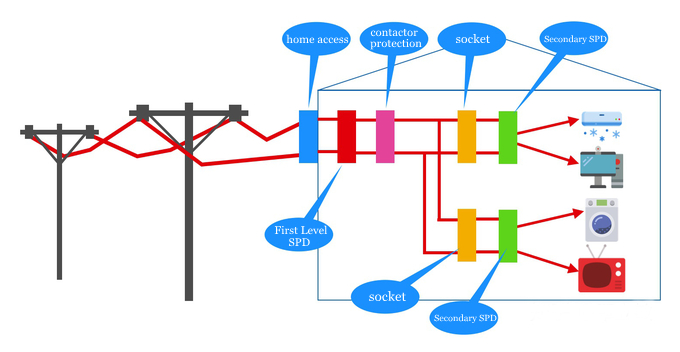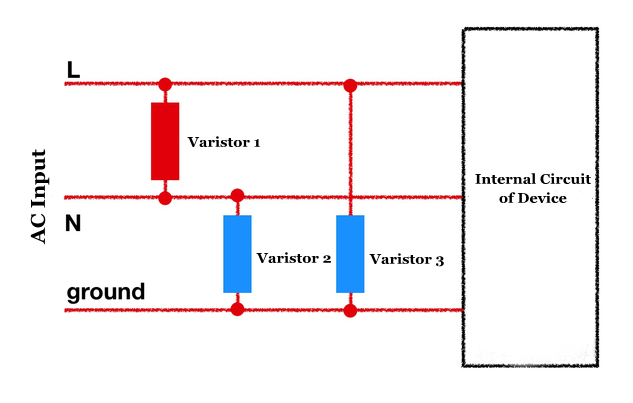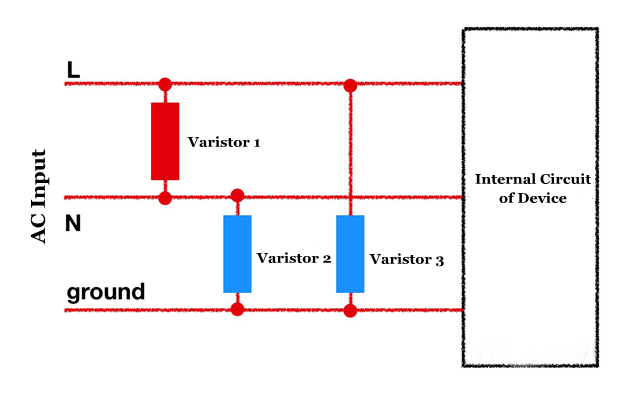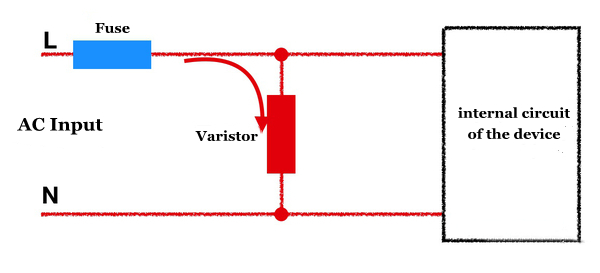The surge protector circuit breaker is actually what we usually call a surge protector device, also called a lightning surge protector. It is a kind of equipment or circuit that provides safety protection for various electrical equipment, instruments, and communication circuits. It is used to absorb the surge or peak voltage between the AC grid to ensure that the equipment or circuit it protects will not be damaged.
The surge protector circuit breaker can handle voltage surges or spikes of thousands of volts, of course, this depends on the parameters and specifications of the selected surge protector. There are also spd surge protectors dedicated to several hundred volts, depending on the user’s use scenario. The surge protector can withstand high voltage spikes in an instant, but the duration of the spike voltage cannot be too long, otherwise the protector will heat up and burn due to excessive energy absorption.
What is a Surge?
Surge is a kind of transient interference. Under certain conditions, the instantaneous voltage on the power grid exceeds the range of the rated normal voltage. Generally, this transient will not last too long, but it may have a very high amplitude. It may be a sudden high in just one millionth of a second. For example, the moment of lightning, disconnecting inductive loads, or connecting large loads will have a great impact on the power grid. In most cases, if the equipment or circuit connected to the power grid does not have surge protection measures, it is easy for the device to be damaged, and the degree of damage will be related to the withstand voltage level of the device.

Under normal working conditions, the voltage at test point is maintained at a stable state of 500V. However, if the switch q is suddenly disconnected, a high voltage surge will occur at test point due to the reverse electromotive force effect due to the sudden change of inductive current.

Two Commonly Used Surge Protection Circuits
1. The first-level surge protector
The first-level surge protection device is usually installed at the entrance of a house or building. It will protect all equipment from the entrance connection point from being persecuted by surges. Usually, the capacity and volume of the first-level surge protector are both It is very large and expensive, but it is essential.
2. Second-level surge protector
The second level surge protector is not as large in capacity as the first level and absorbs less energy, but it is very portable. It is usually installed at the access point of electric equipment, such as socket, or even integrated in the front end of power board of electric equipment to provide secondary protection capability for equipment.
The following figure is a simple schematic diagram of the installation of the surge protection device:

Common Secondary Surge Protection Circuit
For many people, little is known about the secondary surge protection circuit, because most of them are integrated on the power board. The so-called power board is often the front end of the input of many electrical equipment, usually AC-AC, AC-DC circuit is also a circuit that is directly plugged into the socket. The most important role of the lightning protection circuit designed on the power board is to provide timely protection in the event of a surge, such as cutting off the circuit or absorbing the surge voltage, Current.
Another type of secondary surge protection circuit, such as UPS (uninterruptible power supply), some complex UPS power supply will have built-in surge protection circuit, which has the same function as the surge protector on the ordinary power supply board.
How Does the Surge Protection Device Work?
There is a surge protector, which will cut off the power supply in time when the surge voltage occurs. This kind of surge protector is very intelligent and complex. and of course it is relatively expensive, and it is generally rarely used. This kind of surge protector is generally composed of voltage sensor, controller and latch. The voltage sensor mainly monitors whether there is surge fluctuation in the power grid voltage. The controller reads the surge voltage signal of the voltage sensor and timely controls the latch as the on-off of the actuator control circuit when it is judged as a surge signal.
There is another type of surge protector circuit, which does not cut off the circuit when a surge occurs, but it clamps the surge voltage and absorbs the surge energy. This is usually built into the circuit board, such as switching power supply circuits will have this type of surge protection circuit. The circuit is generally as shown in the figure below:

Surge protector 1, across the boundary between the live line and the neutral line, that is, the differential mode suppression circuit. The surge protectors 2 and 3 are respectively connected with the live wire to the earth and the neutral wire to the earth, which is common mode suppression. The differential mode surge device is used to clamp and absorb the surge voltage between the live wire and the neutral wire. In the same way, the common mode surge device is used to clamp the surge voltage of the phase wire to the earth. Generally, it is sufficient to install a surge protector 1 for less demanding surge standards, but for some demanding occasions, common mode surge protection must be added.
Origin of Voltage Surge
There are many factors that can produce surge voltage, generally due to lightning strikes, capacitor charging and discharging, resonant circuits, inductive switching circuits, motor drive interference, etc. The surge voltage on the power grid can be said to be everywhere. Therefore, it is quite necessary to design a surge protector in the circuit.
The Medium that Propagates the Surge
Only with a suitable propagation medium, the surge voltage has the opportunity to destroy the electric equipment.
Power line-Power line is the most important and direct medium for spreading surges, because almost all electrical equipment is powered by power line, and power line distribution network is ubiquitous.
Radio waves-in fact, the main entrance is the antenna, which is easy to receive wireless surges or lightning strikes, which can break down electrical equipment in an instant. When lightning strikes the antenna, it penetrates the radio frequency receiver.
Alternator-In the field of automotive electronics, voltage surges will also be defined with emphasis. Often when the alternator has complex fluctuations, a large surge voltage will be generated.
Inductive circuit-when the voltage at both ends of the inductor changes suddenly, a surge voltage is often generated.
How to Design a Surge Protection Circuit
It is not difficult to design a surge protection circuit. In fact, to design a built-in surge protection circuit, the simplest way only requires one component, that is, a MOV varistor or a transient diode TVS. As shown in the figure below, the surge protectors 1-3 can be varistors MOV or TVS.

Sometimes, it is only necessary to connect a MOV varistor in parallel between the neutral line of the AC power line to meet the IEC standard. In many applications, it is necessary to add a surge protection circuit between the zero live wire and the ground at the same time to meet the higher surge standard requirements, for example, the requirement is higher than 4KV.
Surge Protector for Varistor MOV
Basic characteristics of MOV
1. MOV stands for Metal oxide varistor, metal oxide resistor, its resistance value will change according to the voltage across the resistor. It is usually used between AC power grids to deal with surge voltage.
2. MOV is a special device based on voltage.
3. When MOV works, its characteristics are a bit similar to diodes, non-linear and not suitable for Ohm’s law, but its voltage and current characteristics are bidirectional, while diodes are unidirectional.
4. It is more like a bidirectional TVS diode.
5. When the voltage across the varistor does not reach the clamp voltage, it is in an open circuit state.
Location Selection of Varistor in Surge Protection Circuit
The varistor is a critical component in the surge protector. When designing, make sure that it is as close as possible to the fuse at the input end, as shown in the figure below. In this way, it can be ensured that the fuse can be blown out in time when a surge current occurs, and the subsequent circuit is in an open state to avoid greater damage or even fire caused by the surge current.




 2021-10-07
2021-10-07




















